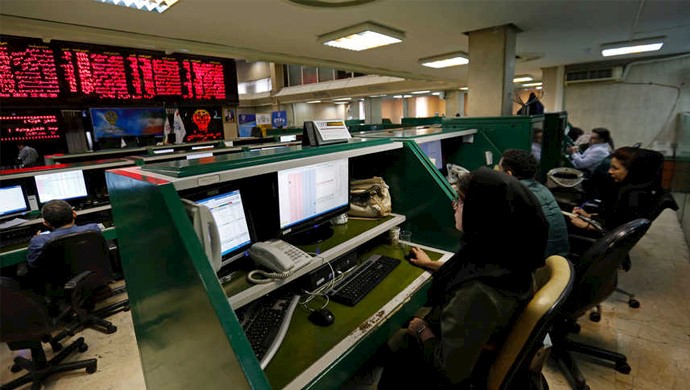Analysis by PMOI/MEK
Iran, May 06, 2020—While the world’s largest and most famous stock markets in the United States, Europe and Asia have tanked during the coronavirus crisis, the index on the Tehran Stock Exchange has grown by an astonishing 80 percent, and the stock market index has grown by an average of 100,000 units per week. This is a strange phenomenon that is not the least similar to the situation in other stock markets of the world or to the economic conditions of Iran, because all economic indicators are currently very negative:
- The inflation rate is 45-50 percent
- The economic growth rate is -7%
- After the outbreak of coronavirus, more than 3 million people lost their jobs, and according to the Parliamentary Research Center, the number will reach 6.4 million.
- Oil revenue has almost reached zero
- Not only is there no foreign investment, but instead, the capital flight continues.
- Long story short, all economic indicators justify the crash of the stock market, not its spike
Regime president Hassan Rouhani ironically claimed the rise of the Tehran Stock Exchange is one of his economic miracles that “the enemies cannot see.” But is this the reality?
The government is facing a terrible budget deficit of 15,000 trillion rials. In order to provide this budget deduction, for this year, it intends to issue 8,000 trillion rials in government bonds and sell 500 trillion rials in stock. On the other hand, it is selling the shares of state-owned companies and government assets in the stock market.
In an article named “Privatization under a new guise,” the state-run Daily Jahan-e Sanat wrote on May 4 that “the government is in dire financial straits… it has lost hope in the revenue from crude oil sales and is not resorting to selling futures.”
The Daily Javan also wrote on May 4 that “the government has a large program for selling assets [to the private sector]; public institutions, pension funds and the Execution of Imam Khomeini’s Order also have plans to sell their companies and so the first financial intermediation fund will be provided to the people.”
Farhad Dejpasand, Minister of Economic Affairs and Finance, estimated the value of the government’s assets at more than 70,000 trillion rials and added: “If 20 percent of the assets can be transferred, it will be 14,000 trillion rials.” This number is almost equal to the government’s budget deficit. But in an open letter, Ahmad Tavakoli, member of the Expediency Council, described these transfers as a great betrayal and said, “After the looting of the nation’s property in the name of privatization, now they want to use the public-private partnership to plunder all the assets of the nation, including schools, hospitals, stadiums, universities, etc., whether they have been completed or under construction.”
“The Minister or Director General can offer an 80-percent discount to deprived sectors and 50 percent to other areas. But it is clear that these major buyers are the same gangs affiliated with power centers, which have already become owners of large industries and complexes at very low prices. In one example, the Haft Tappeh Sugarcane Company with 24,000 hectares of agricultural land and more than 5,000 personnel was sold with a down payment of 60 billion rials in February 2016,” Tavakoli added.
Who will bear the damage?
The real victims of this fraud scheme will be the people. The Rouhani government has cut interest rates from 25 percent to 12 percent, while inflation is more than 40 percent. It has forced small capital owners who see their assets melting to move their funds to a safer location. But in the face of an unprecedented recession, where the currency, gold, housing markets, and virtually all other markets have come to a grinding halt, the only way left for the regime to fill its coffers is to go to the stock market and offer an attractive prospect of 30-percent profits to share buyers. But we’ve already seen this scenario play out with credit institutions, who took a large sum of money from investors and then disappeared by filing for bankruptcy. This is now happening again with the stock market.
When the bubble pops
The question is what will happen after this to the companies and government agencies that have gone public? In fact, they are the property of major buyers, the mafia gangs in power, led by the Revolutionary Guards and the institutions controlled by the Supreme Leader Ali Khamenei.
In an article titled, “The damaged people and the benefiting government,” the state-run Vatan-e Emroz wrote on May 4: “The stock market is in a state of shock, and the main victims are certainly small shareholders who will suffer from the bubble that has engulfed the market. The last shock experience in the Iranian stock market dates back to 2014 and the time of the first Rouhani government, at that time, many people were affected by this market, and the scope of this loss was evident in the years that followed.”
Of course, in the meantime, the government, by looting people’s savings, will temporarily and in the short term solve its budget deficit problem but will sow the seeds of another major upheaval.
In this regard, the Parliamentary Research Center emphasized that the main goal of the government is to generate revenue from the transfer of ownership of enterprises and the rapid provision of budget deficits. It said: “Although this mechanism will solve the short-term problem of the government in a simple way, it will create bigger problems for the country in the future.”
This “big problem” is millions of asset losers who will come to the street together with the army of the poor and this time, like the story of the shareholders of credit institutions, the regime is no longer able to answer them by printing banknotes.





